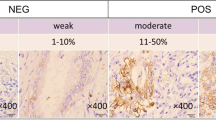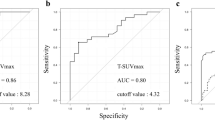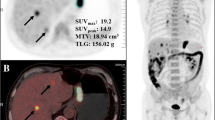Abstract
Objective
Variable uptake of 2-deoxy-2-[18F]fluoro-D-glucose (FDG) has been noticed in positron emission tomography (PET) studies of gastric carcinoma patients, with low uptake occurring especially in some particular histological subtypes and early carcinomas. But this phenomenon has not been adequately explained. The aim of the present study is to clarify FDG uptake in gastric carcinomas especially focusing on histological subtypes, the depth of tumor invasion, and glucose transporter-1 (GLUT-1) expression which is considered to be one of the major factors for higher FDG uptake in human malignant tumors.
Methods
FDG-PET was performed on 35 preoperative patients with gastric carcinoma. Forty macroscopically distinguishable lesions on a surgical specimen were histologically classified into two subtypes: Cohesive type (papillary adenocarcinoma, tubular adenocarcinoma, and solid type poorly differentiated adenocarcinoma) or Non-cohesive type (signet-ring cell carcinoma and non-solid type poorly differentiated carcinoma). GLUT-1 expression was immunohistochemically determined. Histological parameters (GLUT-1 expression, histological subtypes, the depth of invasion, lymphatic permeation, venous invasion and tumor size) were evaluated, and factors for FDG uptake (detectability and the degree) and GLUT-1 overexpression were determined by multiple regression analysis.
Results
Nineteen of 40 gastric carcinomas showed detectable FDG uptake (48%), multiple regression analysis revealed that both the depth of invasion and histological subtypes are independent factors that influence the detectable FDG uptake in gastric carcinoma (R2 = 0.66). GLUT-1 expression was seen from an early cancer stage and the cohesive type was an independent factor influencing the overexpression of GLUT-1 (R2 = 0.66). GLUT-1 expression was the most influential factor for the degree of FDG uptake in gastric carcinoma (R2 = 0.68).
Conclusions
This study provided important information on the clinical application of FDG-PET in gastric carcinoma that early or non-cohesive gastric carcinoma may show lower FDG uptake. Therefore, the usefulness of FDG-PET for the detection of gastric carcinoma is limited. But there is a possibility that FDG uptake associated with GLUT-1 expression may serve as a prognostic factor of gastric carcinoma representing tumor metabolism. Key words: gastric carcinoma, adenocarcinoma, 2-deoxy-2-[18F]fluoro-D-glucose (FDG), glucose transporter type 1 (GLUT-1), positron emission tomography (PET)
Similar content being viewed by others
References
Warburg O. On the origin of cancer cells.Science 1956; 123: 309–314.
Brown RS, Wahl RL. Over expression of Glut-1 glucose transporter in human breast cancer: an immunohistochemical study.Cancer 1993; 72: 2979–2985.
Higashi T, Tamaki N, Honda T, Torizuka T, Kimura T, Inokuma T, et al. FDG uptake, GLUT-1 glucose transporter and cellularity in human pancreatic tumors.J Nucl Med 1998; 39: 1727–1735.
Aloj L, Caraco C, Jagoda E, Eckelman WC, Neumann RD. Glut-1 and hexokinase expression: relationship with 2- fluoro-2-deoxy-D-glucose uptake in A431 and T47D cells in culture.Cancer Res 1999; 59: 4709–4714.
Mochizuki T, Tsukamoto E, Kuge Y, Kanegae K, Zhao S, Hikosaka K, et al. FDG uptake and glucose transporter subtype expressions in experimental tumor and inflammation models.J Nucl Med 2001; 42: 1551–1555.
McAteer D, Wallis F, Couper G, Norton M, Welch A, Bruce D, et al. Evaluation of18F-FDG positron emission tomography in gastric and oesophageal carcinoma.Br J Radiol 1999; 72: 525–529.
Torizuka T, Tamaki N, Inokuma T, Magata Y, Yonekura Y, Tanaka A, et al. Value of fluorine-18-FDG-PET to monitor hepatocellular carcinoma after interventional therapy.J Nucl Med 1994; 35: 1965–1969.
Keiding S, Hansen SB, Rasmussen HH, Gee A, Kruse A, Roelsgaard K, et al. Detection of cholangiocarcinoma in primary sclerosing cholangitis by positron emission tomography.Hepatology 1998; 28: 700–706.
Bares R, Klever P, Hauptmann S, Hellwig D, Fass J, Cremerius U, et al. F-18 fluorodeoxyglucose PETin vivo evaluation of pancreatic glucose metabolism for detection of pancreatic cancer.Radiology 1994; 192: 79–86.
Gupta NC, Falk PM, Frank AL, Thorson AM, Frick MP, Bowman B. Pre-operative staging of colorectal carcinoma using positron emission tomography.NebrMed J 1993; 78: 30–35.
Ishizu K, Sadato N, Yonekura Y, Nishizawa S, Magata Y, Tamaki N, et al. Enhanced detection of brain tumors by [l8F]fluorodeoxyglucose PET with glucose loading.J Comput Assist Tomogr 1994; 18: 12–15.
Kern KA, Brunetti A, Norton JA, Chang AE, Malawer M, Lack E, et al. Metabolic imaging of human extremity musculoskeletal tumors byPET.J NuclMed 1988; 29:181–186.
Kubota K, Matsuzawa T, Fujiwara T, Ito M, Hatazawa J, Ishiwata K, et al. Differential diagnosis of lung tumor with positron emission tomography: a prospective study.J Nucl Med 1990; 31: 1927–1932.
Wahl RL, Cody RL, Hutchins GD, Mudgett EE. Primary and metastatic breast carcinoma: initial clinical evaluation with PET with the radiolabeled glucose analogue 2-[F-18]- fluoro-2-deoxy-D-glucose.Radiology 1991; 179: 765–770.
Annovazzi A, Peeters M, Maenhout A, Signore A, Dierckx R, Van De Wiele C. 18-fluorodeoxyglucose positron emission tomography in nonendocrine neoplastic disorders of the gastrointestinal tract.Gastroenterology 2003; 125: 1235–1245.
Stahl A, Ott K, Weber WA, Becker K, Link T, Siewert JR, et al. FDG PET imaging of locally advanced gastric carcinomas: correlation with endoscopic and histopathological findings.Eur J Nucl Med Mol Imaging 2003; 30: 288–295.
Yoshioka T, Yamaguchi K, Kubota K, Saginoya T, Yamazaki T, Ido T, et al. Evaluation of18F-FDG PET in patients with advanced, metastatic, or recurrent gastric cancer.J Nucl Med 2003; 44: 690–699.
Kim WS, Kim YY, Jang SJ, Kimm K, Jung MH. Glucose transporter 1 (GLUT1) expression is associated with intestinal type of gastric carcinoma.J Korean Med Sci 2000; 15: 420–424.
Kawamura T, Kusakabe T, Sugino T, Watanabe K, Fukuda T, Nashimoto A, et al. Expression of glucose transporter-1 in human gastric carcinoma: association with tumor aggressiveness, metastasis, and patient survival.Cancer 2001; 92: 634–641.
Mochiki E, Kuwano H, Katoh H, Asao T, Oriuchi N, Endo K. Evaluation of18F-2-deoxy-2-fluoro-D-glucose positron emission tomography for gastric cancer.World J Surg 2004; 283: 247–253.
Japanese Gastric Cancer Association. Japanese classification of gastric carcinoma—2nd English edition—.Gastric Cancer 1998; 1:10–24.
Uchino S, Noguchi M, Ochiai A, Saito T, Kobayashi M, Hirohashi S. p53 Mutation in gastric cancer: a genetic model for carcinogenesis is common to gastric and colorectal cancer.Int J Cancer 1993; 54: 759–764.
Ueyama T, Tsuneyoshi M. Poorly differentiated solid type adenocarcinomas in the stomach: a clinicopathologic study of 71 cases.J Surg Oncol 1992; 51: 81–88.
Yokota T, Kunii Y, Saito T, Teshima S, Yamada Y, Takahashi M, et al. Poorly differentiated, solid-type adeno-carcinoma of the stomach.Ups J Med Sci 1999; 104: 207–216.
Fiocca R, Luinetti O, Villani L, Mastracci L, Quilici P, Grillo F, et al. Molecular mechanisms involved in the pathogenesis of gastric carcinoma: interactions between genetic alterations, cellular phenotype and cancer histotype.Hepato-Gastroenterology 2001; 48: 1523–1530.
Graeber TG, Osmanian C, Jacks T, Housman DE, Koch CJ, Lowe SW, et al. Hypoxia-mediated selection of cells with diminished apoptotic potential in solid tumours.Nature 1996; 379: 88–91.
Dang CV, Semenza GL. Oncogenic alterations of metabolism.Trends Biochem Sci 1999; 2: 68–72.
Mathupala SP, Heese C, Pedersen PL. Glucose catabolism in cancer cells. The type II hexokinase promoter contains functionally active response elements for the tumor suppressor p53.J Biol Chem 1997; 36: 22776–22780.
Smith TA. Mammalian hexokinases and their abnormal expression in cancer.Br J Biotned Sci 2000; 2: 170–178.
Author information
Authors and Affiliations
Corresponding author
Rights and permissions
About this article
Cite this article
Yamada, A., Oguchi, K., Fukushima, M. et al. Evaluation of 2-deoxy-2-[18F]fluoro-D-glucose positron emission tomography in gastric carcinoma: relation to histological subtypes, depth of tumor invasion, and glucose transporter-1 expression. Ann Nucl Med 20, 597–604 (2006). https://doi.org/10.1007/BF02984657
Received:
Accepted:
Issue Date:
DOI: https://doi.org/10.1007/BF02984657




